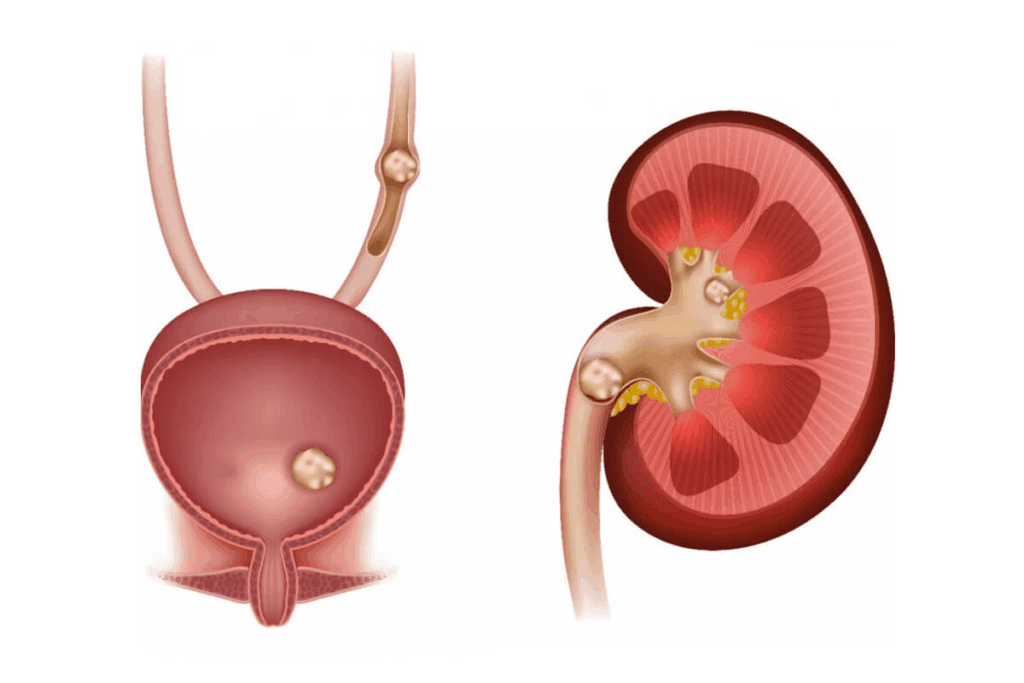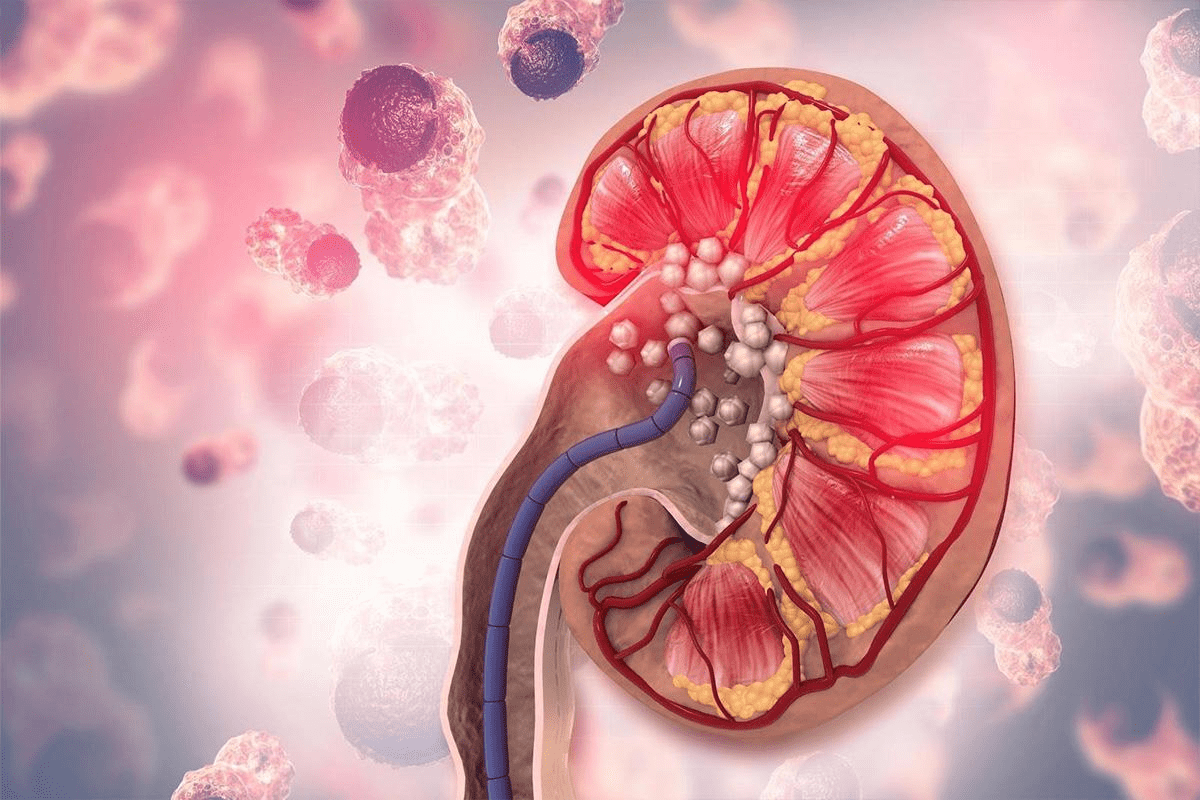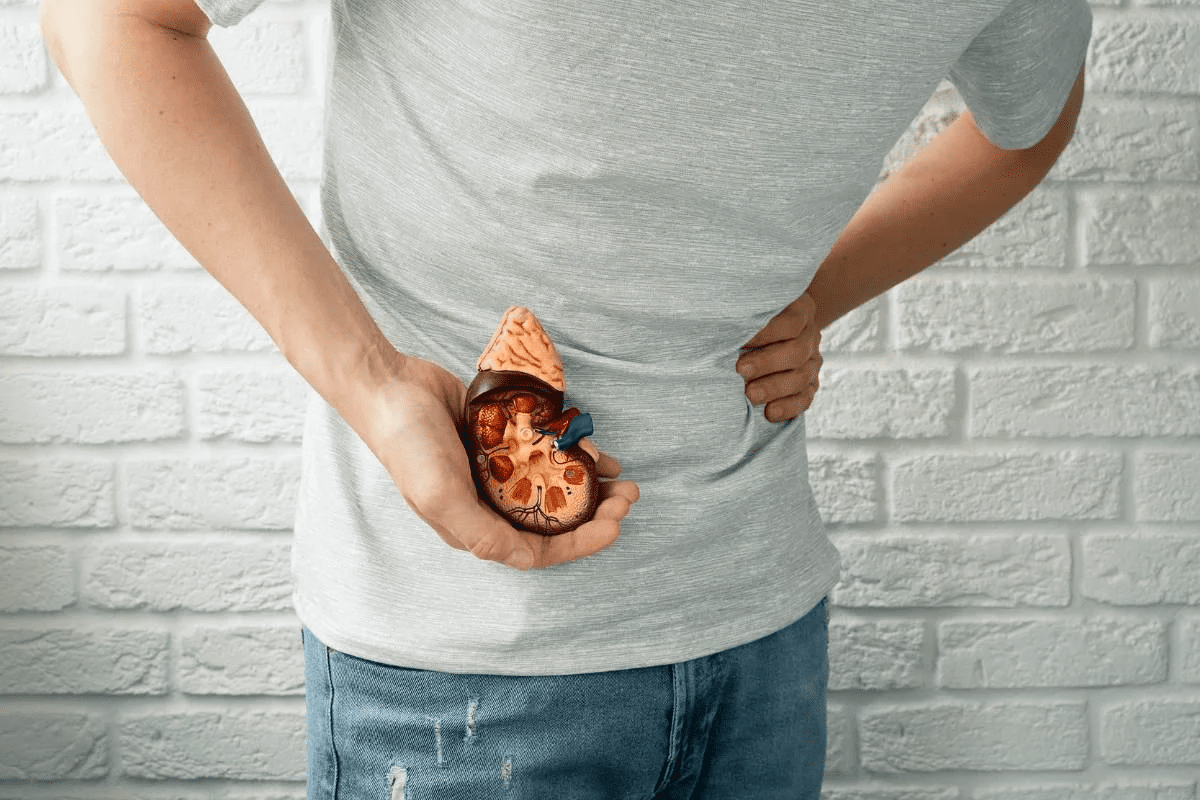Last Updated on November 25, 2025 by Ugurkan Demir

Ureteral stones are a big health problem for millions globally. They can cause a lot of pain and discomfort, known as ureterolithiasis. It’s important to know what causes them and how to treat them.
What is a stone located in the ureter? Learn the medical term (ureteral calculus) and the severe symptoms associated with this condition.
This article will cover ureteral stones, their symptoms, and treatment options. We aim to help you understand this condition better.
Ureteral stones are a common problem worldwide. They are small, hard mineral deposits in the ureters. This causes a lot of pain and discomfort. Knowing the causes, symptoms, and treatments is key to managing it well.
Many things can lead to ureteral stones. Dehydration, certain diets, and genetics are among them. Eating a lot of animal protein, sodium, and oxalate increases the risk. Family history also matters a lot.
Symptoms include severe pain that moves from the lower back to the groin. You might also feel nauseous and vomit. The pain is usually very intense and is a clear sign of ureteral stones.
To prevent ureteral stones, change your diet. Eat less of foods high in oxalate and drink more water. Treatment varies. It depends on the stone’s size and where it is.

Recent studies have shed light on the global prevalence and demographics of ureterolithiasis. This highlights its impact on public health. Understanding the epidemiology of kidney stones is key for effective prevention and treatment.
The lifetime risk of developing ureteral stones varies between men and women. Data show that about 12% of men and 7% of women will get ureteral stones. These stones are more common in middle-aged and older adults.
Certain groups are more at risk due to genetic and environmental factors.
The global prevalence of ureterolithiasis is increasing. This is due to changes in diet, lifestyle, and possibly climate change. The prevalence is higher in some regions, possibly due to diet, hydration, and socioeconomic factors.
Several factors increase the risk of kidney stones. A family or personal history of stones is a big risk factor. This suggests a genetic link. Other risks include dehydration, certain diets, obesity, and digestive diseases like Crohn’s disease and ulcerative colitis.
Understanding these risk factors is vital for preventing and managing ureteral stones. By identifying high-risk individuals and taking preventive steps, we can lower the incidence and recurrence of kidney stones.
Kidney stones form when urine’s mineral balance is off. This imbalance causes minerals to crystallize. Dehydration, diet, and genetics play big roles in this.
There are many types of kidney stones. These include calcium, uric acid, struvite, and cystine stones. Knowing the type and cause is key to preventing and treating them.
To prevent stones, stay hydrated and eat well. Also, manage any health issues you have. Learning about stone formation helps you lower your risk and manage your condition better.

Kidney stones can cause a range of symptoms, from mild discomfort to severe pain. The classic symptom is a sharp, crampy pain in the flank or lower back. This pain can radiate to the groin or abdomen.
Patients with kidney stones may also experience nausea and vomiting. In some cases, they may have blood in their urine, known as hematuria. The pain can be either intermittent or constant. It may also be accompanied by fever and chills if an infection is present.
Understanding these symptoms is key to seeking timely medical attention and getting the right treatment.
Passing a kidney stone is a complex process with multiple stages. Knowing these stages can help people better understand this challenging experience.
The first stage is the formation of a kidney stone. Stones can form due to dehydration, certain diets, and genetics.
After a stone forms, it moves into the ureter. This movement causes severe pain as it goes towards the bladder.
The stone then enters the bladder. Here, it can cause discomfort and pain.
Lastly, the stone is expelled from the body through the urethra. This marks the end of the painful process.
Diagnosing ureteral stones is a detailed process. It starts with a full medical history and physical check-up. Then, it moves to using diagnostic imaging.
Imaging, like non-contrast computed tomography (NCCT), is key. It’s very good at finding stones and spotting any problems.
Laboratory tests also play a part. They check for infections or other issues in the urinary tract. Urinalysis can show if there’s blood in the urine, a sign of stones.
Together, clinical checks, imaging, and lab tests help doctors find and treat ureteral stones well.
Treating kidney stones depends on the stone’s size, location, and type. It also depends on the patient’s health. Treatment can range from simple care to more serious surgeries.
For small stones, doctors often start with simple care. This means watching the stone move and using pain medicine. Patients are told to drink lots of water and may get more medicine to ease pain.
Medical expulsive therapy (MET) uses medicine to help the stone move. Alpha-blockers, like tamsulosin, relax the ureter’s muscles. This makes it easier for the stone to pass.
For big stones or severe symptoms, surgery is needed. Options include shockwave lithotripsy (SWL), ureteroscopy, and percutaneous nephrolithotomy (PCNL).
Choosing a treatment depends on many things. These include the stone’s size, location, and the patient’s health. A doctor will look at these factors to pick the best treatment.
Complications of Kidney Stones Stuck in the Ureter
Ureteral stones can cause severe complications, including obstruction and infection. When a kidney stone gets stuck in the ureter, it blocks urine flow. This leads to various health issues.
One major problem is urinary obstruction. This blockage can cause urine to back up into the kidney. It can swell and potentially damage the renal tissue. Urinary obstruction also raises the risk of urinary tract infections (UTIs).
UTIs are serious because they can lead to pyelonephritis or sepsis if not treated quickly. Symptoms include fever, chills, and painful urination. If you have these symptoms, you should see a doctor right away.
Prolonged obstruction from a kidney stone can damage the kidneys. The pressure from backed-up urine can harm kidney function. If not treated, it may cause permanent damage. In severe cases, this can lead to chronic kidney disease or kidney failure.
It’s important to know that the longer a stone stays stuck, the higher the risk of long-term problems. Quick medical help is key to prevent these issues and ensure the stone is removed or passed safely.
“Timely treatment of ureteral stones is critical to prevent complications such as urinary obstruction and kidney damage.”
In conclusion, the complications from kidney stones stuck in the ureter are serious and can affect urinary health for a long time. Knowing these risks highlights the need for medical care if symptoms don’t get better or get worse.
Passing a kidney stone can feel like a huge relief. But, it’s important to make sure the stone is really gone. Here are some signs to watch for:
If you think you’ve passed a kidney stone, seeing a doctor is key. They can confirm it and help you avoid future stones.
To prevent kidney stones, it’s important to make dietary changes and lifestyle adjustments. Understanding the causes helps in taking preventive steps. Staying hydrated, eating a balanced diet, and living a healthy lifestyle are key.
Understanding ureteral stones is key to managing them well. Knowing the causes and symptoms helps people get help fast. Working with doctors can lower the risk of getting these stones.
It can also help manage them if they do occur. Good management and prevention can greatly improve life for those with ureteral stones.
Ureterolithiasis is when a stone is in the ureter. The ureter connects the kidney to the bladder.
Symptoms include severe pain in the side or back. You might also feel nausea, vomiting, and have trouble urinating.
Kidney stones can happen for many reasons. Dehydration, diet, and genetics are some causes.
Doctors use a few ways to find kidney stones. They look at your medical history and do a physical exam. They might also use X-rays or CT scans and do lab tests like urinalysis.
There are a few ways to treat kidney stones. You might just need to wait it out, take medicine, or have surgery.
To avoid kidney stones, change your diet, drink lots of water, and manage any health issues you have.
If you don’t treat kidney stones, they can cause problems. These include blockages, infections, and damage to your kidneys.
You might see small stones or gravel in your urine. If your pain goes away, it could mean you’ve passed a stone.
Small stones, under 5 mm, can pass without treatment. You just need to wait it out.
Yes, you can prevent kidney stones. Drink plenty of water, eat well, and manage your health.
Doctors have a few ways to treat kidney stones. You might just need to wait, take medicine, or have surgery.
Kidney stones can lead to serious problems. These include blockages, infections, and damage to your kidneys if not treated.
Yes, you can pass a kidney stone on your own. But, if you have symptoms or a history of stones, see a doctor.
Drink lots of water, eat well, and manage your health. These steps can lower your risk of getting kidney stones.
Ureter Stone- https://www.sciencedirect.com/topics/medicine-and-dentistry/ureter-stone
Subscribe to our e-newsletter to stay informed about the latest innovations in the world of health and exclusive offers!